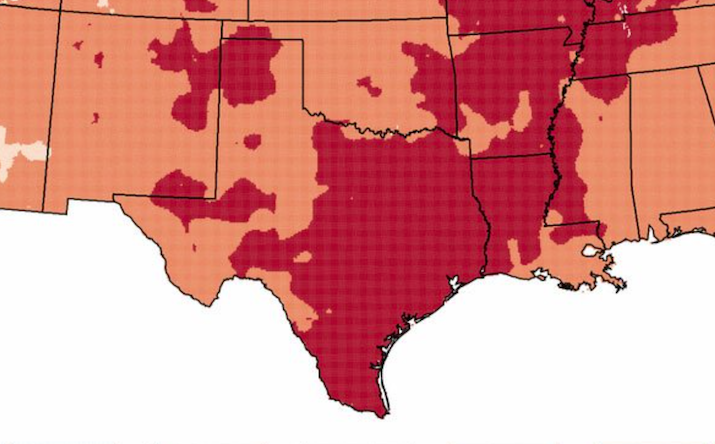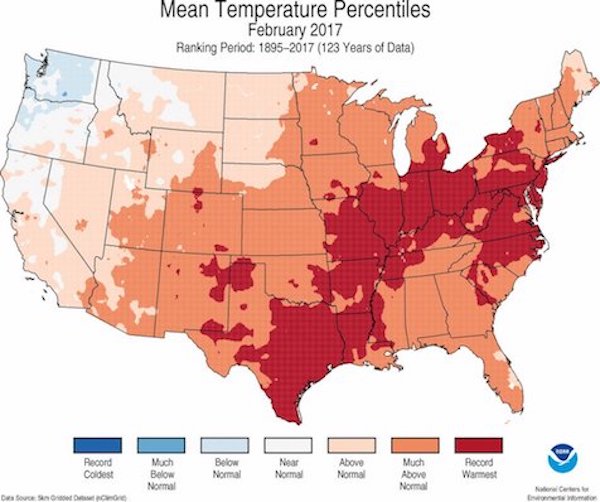
Detail of a map showing temperatures in February. Red areas had “record warmest” readings, while they were “much above normal” in orange areas. The full map produced by the National Oceanic and Atmospheric Administration is below.
By Bill Dawson
Texas Climate News
For three years in a row – 2014, 2015 and 2016 – global temperature averages have climbed to new annual peaks, with each successive year becoming the planet’s hottest on record. Scientists declared manmade warming was a major factor.
It’s still too early for researchers to hazard confident predictions that 2017 will set a fourth consecutive worldwide record, but the year is certainly off to another warm start in Texas and in the contiguous United States.
And World Weather Attribution, an international team of climate researchers, has already concluded in an analysis that “human-caused climate change played a role in the extreme heat that warmed much of the United States in February.”
“If this February felt warm to you in Texas, you were not alone!” the Office of the Texas State Climatologist reported on Facebook Tuesday, adding that it was the state’s hottest February in records dating to the 1890s.
The National Oceanic and Atmospheric Administration (NOAA) announced a day later that the contiguous U.S. had its second hottest February in national records also stretching back to the last decade of the 19th century – 7.3 degrees F above the 20th century average.
It was nearly 8 degrees above normal last month in the Lone Star State. John Nielsen-Gammon, the state climatologist and a professor at Texas A&M University, assembled a list of 42 weather stations across the state where record daily temperatures were recorded in February, including readings in the 100s at nine locations.
The National Weather Service reported, meanwhile, that for the first time in 67 years, Houston had no measurements in the 30s in February – the city’s lowest reading that month was 40 on Feb. 16.
World Weather Attribution, the international research coalition that specializes in rapid analyses of possible human fingerprints on phenomena like February’s temperatures in the U.S., reported Wednesday that its scientists had concluded climate change boosted “both the intensity and frequency” of this warmth across much of the country.
Said Geert Jan van Oldenborgh, senior researcher at the Netherlands Meteorological Institute, one of the coalition members:
“We found clear and strong links between last month’s record warmth in the United States, and climate change. Temperatures like those seen across the Lower 48 this past February are becoming more and more common as cold winter months are getting rarer. The observations show a clear trend, and climate models confirm it is caused by greenhouse gases.”
February also capped a much warmer-than-average winter in the contiguous U.S. (which weather and climate experts define as December through February), NOAA said.
The 2016-17 winter period in Texas was the state’s warmest on record, at 5.7 degrees above its 20th century average, the federal agency said. The contiguous U.S. had its sixth warmest winter, 3.7 degrees above the average in the last century.
In general terms, more warmth is in store, Nielsen-Gammon told a Houston audience last month.
Speaking about anticipated or possible climate-change impacts solely in the Houston area, he assigned different degrees of likelihood to several effects of global warming on the metro area around the Bayou City.
“Increased heat” was in the state climatologist’s “certain” category, along with “increased sea level.”
In his second-most-likely group of impacts (the ones he said he thinks will “probably” occur) were “increased hurricane damage risk” and “increased drought.”
“Increased drought” earned an asterisk from Nielsen-Gammon. He said his “probably” ranking applies “if increased drought means drier soils and higher water demand due to more sporadic precipitation and higher temperatures,” but not if it means “less precipitation.”
+++++
Bill Dawson is the founding editor of Texas Climate News. John Nielsen-Gammon is a member of TCN’s volunteer Advisory Board. Members have no editorial authority at TCN.

